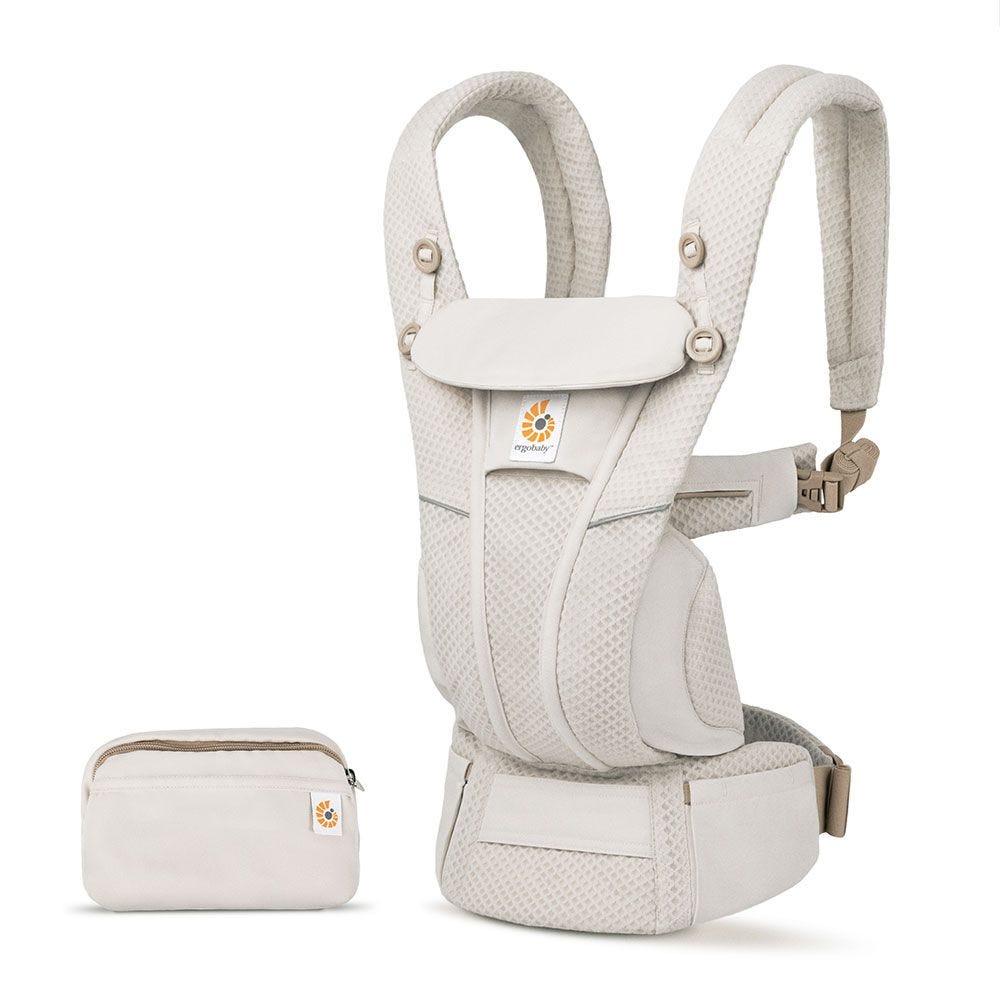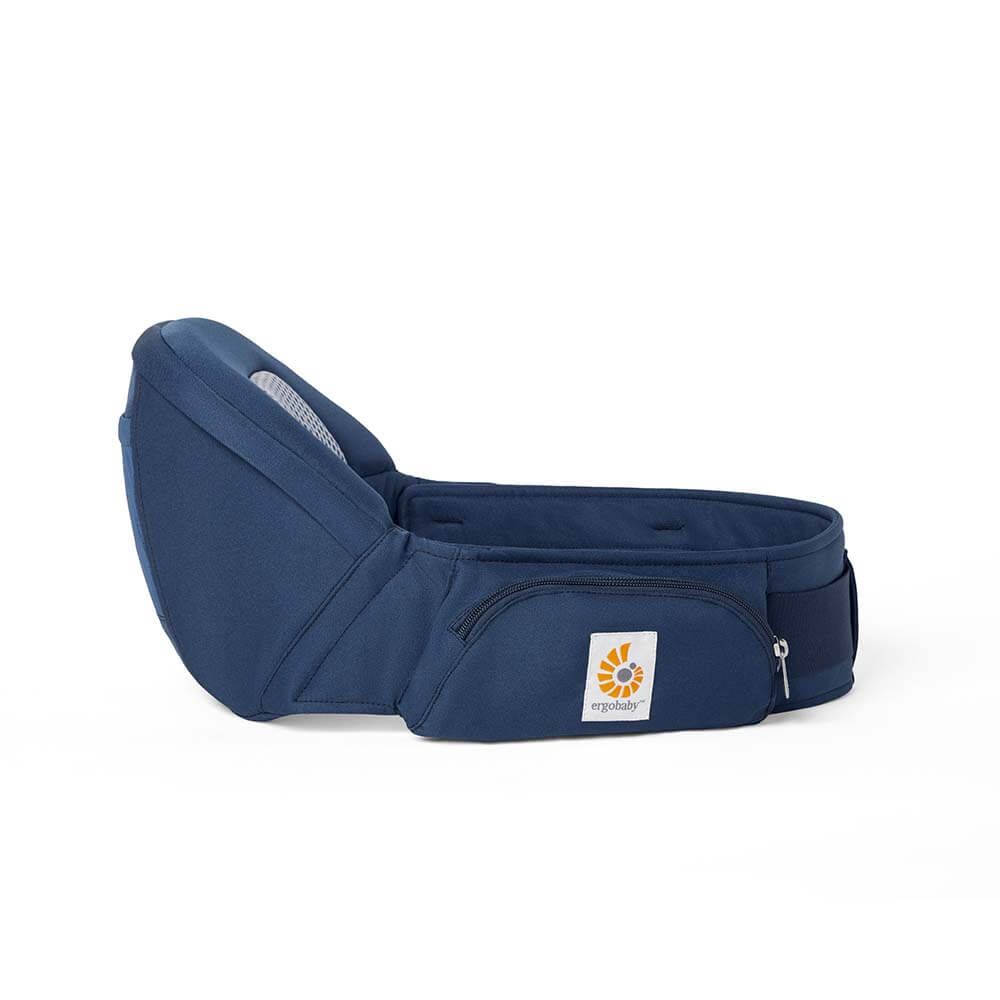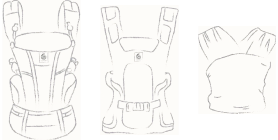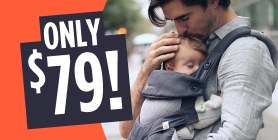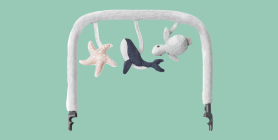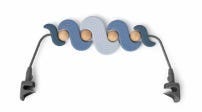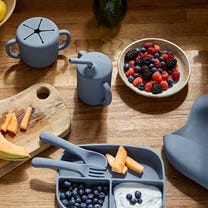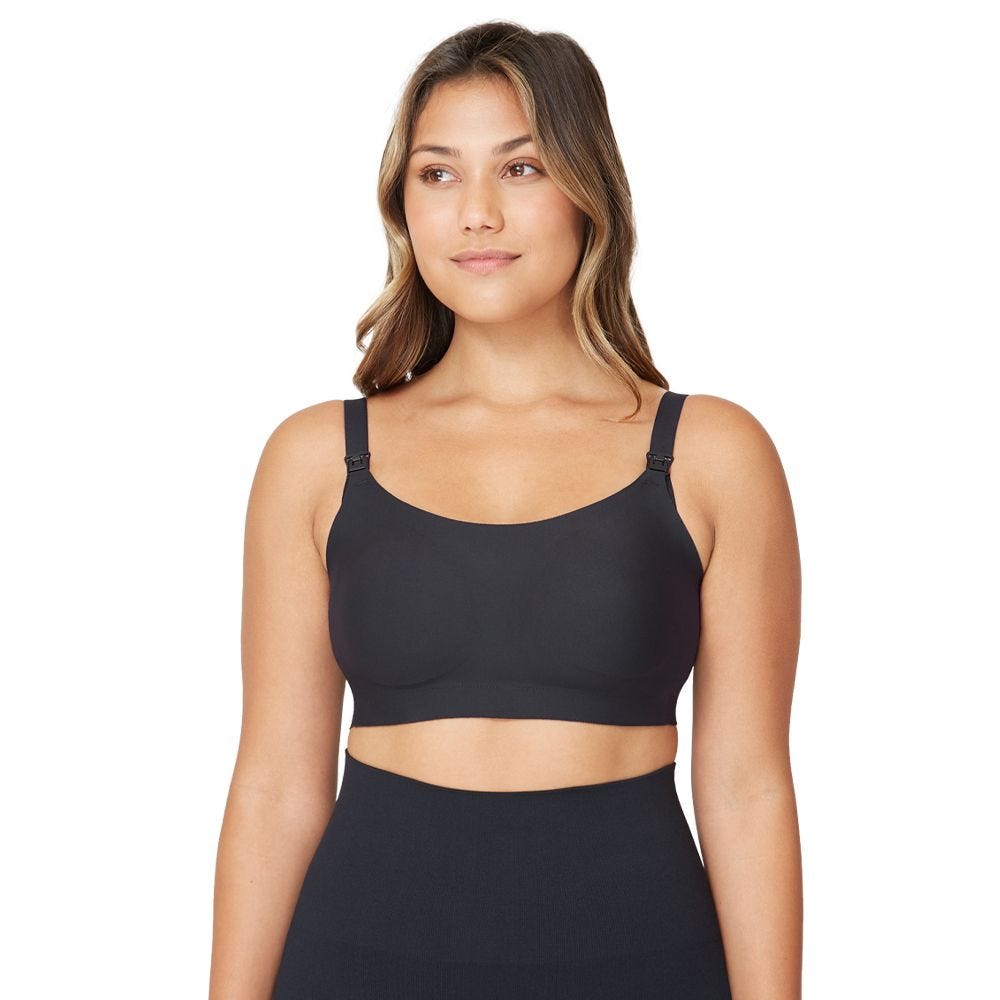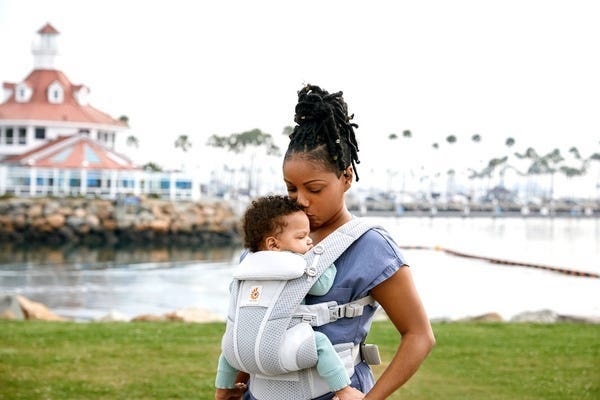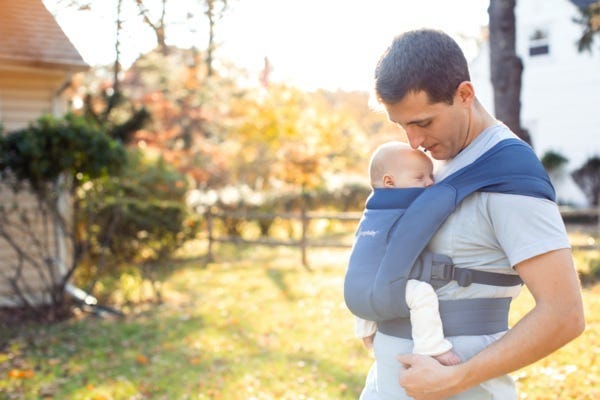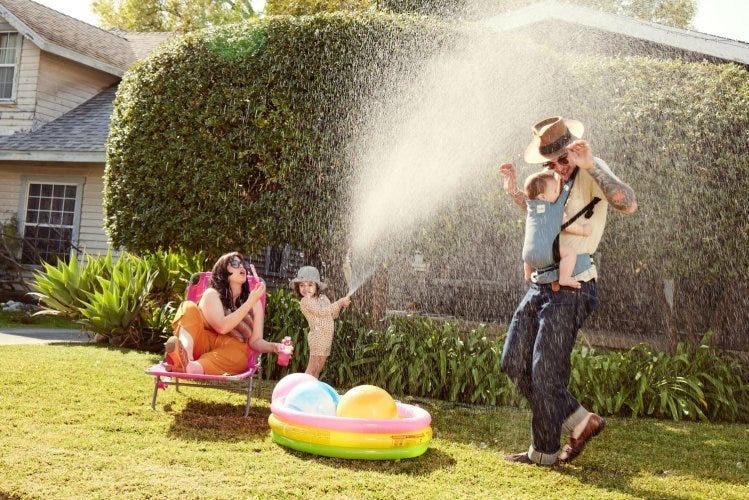
You spent 9 months (give or take) carrying your baby 24/7. Your baby spent those 9 months safely and snugly against you. It’s not surprising that many babies' favorite way to sleep during the fourth trimester[1] is being held by their mom! Who wouldn’t sleep soundly in the cozy confines of their mom?Your baby being held in a baby carrier is similar to them being held in your arms. It’s warm, cozy and mimics the closeness you and your baby had during your pregnancy. But is it safe for your baby to nap in a baby carrier? Will napping in a carrier create bad sleeping habits? Read on to learn everything you want and need to know about babies sleeping in baby carriers.
1. Is it safe for a baby to sleep in a carrier?
As long as you are using a baby carrier correctly and safely, it should be safe for your baby to nap while you carry them in a carrier. The American Academy of Pediatrics (AAP) recommends that babies sleep alone on their backs on a firm, flat surface without any loose blankets, pillows, toys or other people[2]. They say this is the safest way for babies to sleep and that it helps reduce the risk of Sudden Infant Death Syndrome (SIDS). However, especially in the first few months of a baby’s life, the only way for some parents to get their babies to nap is to hold them or place them in a baby carrier.
All About Baby Carriers for Nature Adventures
Some people say letting your baby sleep in a carrier may not be safe because there is a risk of positional asphyxiation, as well as possible suffocation if your clothes or skin cover your baby’s nose and mouth. Others say napping in a carrier is safe because you can constantly monitor your baby. The AAP recommends room sharing for the first 6-12 months of a baby’s life because it can decrease the risk of SIDS by up to 50%[3]. Newborns nap a lot. It’s not realistic for you to sit and watch your baby sleep 3-5 times a day. If your baby is sleeping safely in a carrier, you can not only regulate their breathing to prevent SIDS, but you can also reduce their risk of developing a flat spot on the back of their head. You can also have more bonding time and more flexibility to get things done. Napping in a carrier may even help your baby go to sleep easier at night and get on a good sleep schedule. This is because the close contact with mom helps them stay calm and get more peaceful rest during the day.
2. Is it OK if your baby naps in a carrier most of the time?
This question depends on who you ask. One child sleep expert may tell you it’s OK, while another may say napping in a carrier is bad. Your mom may tell you she never did that with you, but your sister may tell you she’s done it with all of her kids. Here’s the thing: sleeping in a carrier is biologically normal for babies. Why? Because babies can’t do anything for themselves. They are born depending on their mom for survival. They feel safe and secure by the warmth and familiar scent of their mom. So it only makes sense that your baby wants to be close to you and that they feel safest, and can sleep more soundly, when they’re right next to you in a carrier. Here are some other reasons why napping in a baby carrier is OK:
- You can teach your baby the difference between short, daytime naps in a carrier and long, nighttime sleeps in a crib.
- Your baby has more time to bond with you or another caregiver.
- It may be a more helpful and preferred napping position for babies who suffer from reflux or colic.
3. What if my baby only sleeps in a carrier?
It can be exhausting if your baby will only nap in a carrier. You want some separation, such as some alone time to nap yourself or eat lunch. If you can, enjoy this season. (It’ll pass faster than you think!) Sleeping in a carrier is normal and natural, especially for newborns. Your baby was inside your womb for a long time. They got used to your heartbeat, warmth and smell while they slept. It may be hard some days, but think of letting your baby nap in a carrier now as a way to help them develop healthy and positive sleep associations and development in the future. If being close to you in a carrier makes your baby feel safe and ensures a happy naptime, then be reassured. Past experiences and research have shown that babies with positive sleep associations are more likely and more easily able to develop healthy, independent sleeping habits when they’re older. Plus, a well-rested baby usually means a happier baby during the day and a calmer baby during the night, which is a win-win for parents everywhere. If you need some tips on how to get your baby to fall asleep somewhere besides a carrier, try swaddling your baby or using a baby sleep sack if your baby is too old for a swaddle.
Using tools and trackers to create a healthy sleep routine. The Smart Sleep Coach App is our favorite baby sleep coach app due to the easy sleep tracking and the additional support and guidance provided by sleep and medical experts.
4. Is a carrier, wrap, or sling better for sleeping babies?
You can use a soft-structured carrier, wrap or sling for sleeping babies. Some parents prefer wraps because they’re made of soft, stretchy fabric, while others favor soft-structured carriers because they’re the most supportive style and the easiest for first-time parents. Still, other parents prefer slings because they’re easier to use than wraps and usually aren’t as hot as soft-structured carriers.
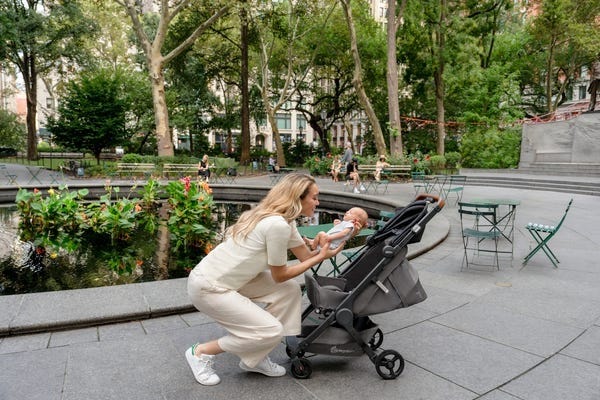

Advantages of Using Strollers for Nature Adventures
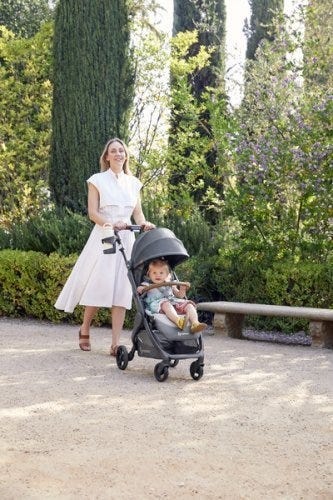

While baby carriers are fantastic for mobility and closeness, depending on the adventure of choice you might want to be a stroller along too.
There are a LOT of baby stroller options on the market. So we understand how confusing it can be to choose the one that’s right for your family. Not only are there a variety of brands, but a variety of strollers that serve different purposes.
There are a few types of strollers on the market:
- Full-sized stroller: This is typically the stroller parents thing of buying for all its versatility.
- Lightweight or umbrella stroller:These compact strollers are perfect for on-the-go adventures.
- Jogging stroller: Designed for parents who want to combine fitness with outdoor adventures.
- Double stroller: Designed for parents with multiple kids, especially twins.
- Car seat carrier: These strollers connect to a specific car seat. We don't typically recommend these as they can be unsafe for baby and uncomfortable for parents who are pushing.
Learn more about the types of strollers and which one would be best for you.
Soft Structured Carriers
Pros:
- Easy to master
- Easy to get a baby in and out of
- Can easily adjust a baby while using carrier
- Padded straps and waist belts for wearer’s comfort
- Offer different positions and carrier accessories
- Can be used from newborn through toddlerhood
Cons:
- Undoing the buckles could wake your sleeping baby
- Bulkiest and usually the most expensive carrier type
Stretchy Wraps
Pros:
- Easily adjusts to different body types
- Soft, comfortable fabric
- Perfect for newborns as it mimics the feel of being in the womb
- Lightweight and travel-friendly option
Cons:
- Can take some time and practice to get used to
- Doesn’t offer the best support for the wearer as a baby grows
Ring Slings:
Pros:
- Easier to use than wraps
- Lightweight, which is good for wearing in hotter climates
- Variety of carrying positions
Cons:
- Can be a learning curve
- Not the most comfortable for long-term wear
- Ring can dig into your shoulder if not positioned properly
Which baby carrier is best for you is ultimately up to you and your baby.
5. Can babies sleep in front and back carry positions?
It is not safe for a baby to sleep in a back carry position. Even when they have strong neck support, you can't monitor them as easily when they are on your back. If you're baby starts to nod off or get sleepy we recommend switching them to a front inward carry position so you can check on your baby to ensure they’re sleeping safely. It is also easier to successfully transfer a sleeping baby from a front carry position.
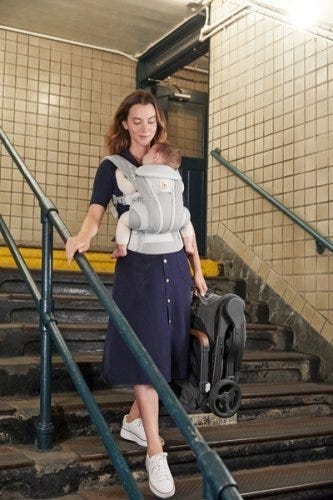

6. How do I transfer my sleeping baby from a carrier to their crib?
You’ve heard of babywearing, but have you heard of “unwearing?” It’s taking off a carrier and a sleeping baby—which isn’t as simple as you might think. Follow these unwearing tips so you can successfully remove your sleeping baby from a carrier without waking them:
Wait until your baby is really asleep.
Think your baby is snoozing? Wait 5-10 more minutes. The last thing you want is to wake your baby after you just spent the time putting them to sleep.
Have the necessities ready.
If your baby needs a pacifier, bottle or white noise machine, have those things ready before you start to unwear.
Be right next to their crib.
The closer you are to the crib, the better your chances are of keeping your baby asleep. If you’re doing a front carry, you can even lean into their crib or a flat, firm and safe surface[4] before taking off the carrier so you don’t have as far to lay down your baby.
Tenderly sway.
Don’t stop and then remove the carrier. Move a little from side to side. This small action will hopefully help hide the fact from your baby that you’re removing them and the carrier.
Take it slow.
Slow and steady is how the tortoise won the race, and it’s how you’re more likely to successfully transfer a sleeping baby. You want slow, fluid movements. That being said, be like the hare and quickly (and quietly) get out of the room once your baby is safely lying down.
Use a wrap.
While I can’t say enough good things about soft-structured carriers, noisy buckles or velcro fasteners might wake your baby. Wraps provide for a quiet, smooth transfer. You also don’t have to worry about removing a wrap from under your baby. It’s safe for them to lay down on, and you can even use it to swaddle your baby.
Have your baby in a front carry position.
If your baby is old enough and likes back carries, consider doing a front carry if you plan on them falling asleep. It’s not impossible to transfer from a back carry, but it’s definitely easier with a front carry.
Try it more than once.
If your baby wakes up the first couple of times you try unwearing them, it’s OK. Try again. With practice, you’ll learn what you need to do and become more confident until you become a professional unwearer.
7. If my baby naps in a carrier during the day, will that affect their nighttime sleep?
Some parents worry that letting their baby nap in a carrier will create bad sleeping habits. Letting your baby sleep in a carrier during the day shouldn’t create bad habits or negatively affect their nighttime sleep. If you don’t believe me, trust the experts from the parenting and health care website, AskDr.Sears.com. One of its babywearing articles states that letting babies sleep in a baby carrier is both physically, emotionally and developmentally beneficial. “Babywearing exerts a regulatory effect on the baby, primarily through the vestibular system. … Activities such as rocking and carrying stimulate the baby’s vestibular system,” the article says. “Vestibular stimulation is a recently appreciated tool for helping babies (breathe) and grow better, especially premature infants—those at highest risk of SIDS. … Babies themselves recognize that they need vestibular stimulation… Researchers believe that vestibular stimulation has a regulating effect on an infant’s overall physiology and motor development.”[5] Babies need healthy and positive sleep associations to sleep better now and to develop good long-term sleep habits. Some babies feel safer, happier and calmer—all the positive associations—and they are more easily soothed when in close contact with their mom. One could also argue that using a carrier for daytime naps helps babies tell the difference between shorter daytime sleeps and longer nighttime sleeps. So don’t think that you’re creating bad sleep habits or spoiling your baby by letting them nap in a carrier. You may actually be doing them and yourself a favor by helping them develop better long-term sleeping habits. Using tools and sleep trackers for babies healthy sleep routine can show parents the progress along the way.
8. How long can a baby sleep in a baby carrier?
Whether sleeping or awake, there isn’t an exact time limit for carrying your baby in a carrier. But there is some consensus among doctors, like Danelle Fisher, M.D., who specializes in pediatrics, to only leave a baby in a baby carrier for 1-2 hours before giving them and their hips a break. Dr. Fisher said, “This is not meant to be a position that the baby should be in for several hours.” It’s best to give babies a break from the carrier so they can move their hips around and prevent getting overextended[6]. There are other safety and developmental risks to consider with prolonged babywearing, such as hip dysplasia, overheating and container baby syndrome[7].
9. Can you sleep while wearing your baby?
No, you shouldn’t sleep while babywearing. Dr. Gina Posner, a pediatrician in California, notes that it’s not safe to sleep while your baby sleeps in a carrier. She said, “The problem with sleeping with your baby while wearing [them] is that their head can drop and constrict their breathing. They can also suffocate themselves in the carrier.”[8] Many parents follow the T.I.C.K.S. rule for safe babywearing.
To follow these guidelines and keep your baby safe while in a carrier, you need to be aware of your baby at all times. If you’re sleeping, you’re not aware of anything; you can’t check on your baby’s position or ensure they’re breathing correctly. Your muscles relax when you sleep, which causes your body position to change. This too could be harmful to your baby because the carrier may not be as tight and supportive as it’s supposed to be. If you’re a new parent or soon-to-be parent, you probably have a lot of sleep-related questions. There is so much information out there about babies and sleep. Hopefully these baby carrier sleep questions and answers have given you some peace of mind. They should also give you the tips and tools for you and your baby to get some much-needed sleep. Sources
- https://www.healthline.com/health/pregnancy/4th-trimester#4th-trimester-for-parents
- https://www.aap.org/en/patient-care/safe-sleep/
- https://www.healthychildren.org/English/ages-stages/baby/sleep/Pages/A-Parents-Guide-to-Safe-Sleep.aspx
- https://blackchildlegacy.org/wp-content/uploads/2017/04/How-to-Keep-Your-Sleeping-Baby-Safe_-AAP-Policy-Explained-HealthyChildren.pdf
- https://www.askdrsears.com/topics/health-concerns/sleep-problems/sids/3-reasons-babywearing-reduces-sids/
- https://www.parents.com/baby/safety/tips/safety-tips-for-wearing-a-baby-carrier/
- https://www.todaysparent.com/baby/baby-development/what-is-container-baby-syndrome-and-do-i-really-have-to-worry-about-it/
- https://www.romper.com/p/can-i-sleep-while-wearing-my-baby-a-pediatrician-explains-11771492

